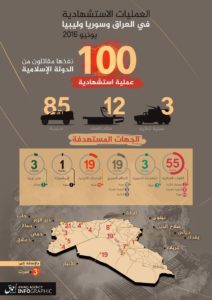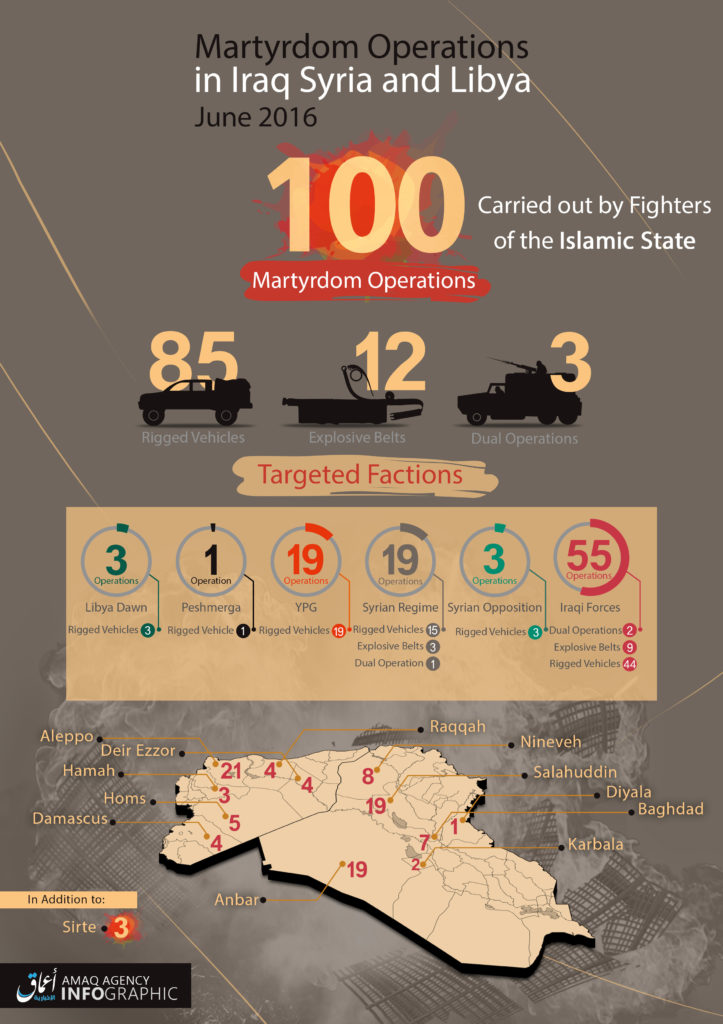The Islamic State claims to have executed 589 “martyrdom operations” in Iraq, Syria and Libya during the first six months of 2016. The figure comes from monthly data published by Amaq News Agency, a propaganda arm of the so-called caliphate that releases infographics summarizing the group’s suicide attacks.

Amaq’s most recent infographic (seen on the right) indicates that the jihadists executed 100 “martyrdom operations” in the month of June alone.
If Amaq’s figures are accurate, then the Islamic State is launching suicide attacks at a historically high rate.
The Long War Journal previously reported that all terrorist organizations around the globe averaged just over 60 suicide attacks per month in 2015. In all previous years from 2005 through 2014, the total number of suicide attacks by all groups never reached 50 per month. According to Amaq’s figures, the Islamic State is currently surpassing the historical high all by itself, averaging nearly 100 “martyrdom operations” per month for the first six months of 2016. [See LWJ report, The Islamic State’s prolific ‘martyrdom’ machine.]
The Long War Journal cannot independently verify the data contained in Amaq’s infographics. It is possible that the so-called caliphate’s media front is exaggerating the number of suicide missions carried out by its members. However, the figures are generally consistent with the scale of the fighting in Iraq and Syria, where the Islamic State is fighting multiple actors.
Brett McGurk, who serves as the Special Presidential Envoy for the Global Coalition to Counter ISIL (Islamic State), recently tweeted that the group “has averaged nearly 60 suicide bombers per month.” McGurk did not give a timeframe for his monthly average, which is significantly lower than Amaq’s claims.
Even at almost 60 “martyrdom” operations per month the Islamic State would be launching such attacks at a rate close to the historical high. Suicide operations are less common than other types of attacks. But the jihadists rely on kamikaze-style bombings because they tend to be more lethal, on average, than other means for assaulting enemy positions and civilians.
The Islamic State’s prolific use of “martyrs” probably highlights both its strength and weakness.
On the one hand, there are likely more people, predominately young men, willing to die for the jihadists’ cause today than ever. (It should also be noted that adolescents and even children have been used in suicide attacks.) On the other hand, most of the organization’s suicide attackers are being dispatched in areas where the “caliphate” is being challenged, including locations that were once under its control.
The Long War Journal assesses that the Islamic State is being forced to deploy many of its “martyrs” because its territorial claims are being rolled back in Iraq, Syria and even Libya.
The Long War Journal has tallied the figures provided on Amaq’s infographics from January through June of 2016. The English-language version of the infographic for June can be seen below. The infographics for the previous months can be viewed here.
The following observations have been culled from Amaq’s statistics.
Most of the Islamic State’s “martyrdom operations,” 359 of the 589 claimed (61 percent), have been carried out inside Iraq. Nearly half of these (171 of 359) have been launched in Anbar province, where the jihadists have lost significant territory and have been engaged in fierce battles with Iraqi government forces and Iranian-backed Shiite militias for months. Salahuddin (71 suicide attacks), Nineveh (48), Baghdad (39), and Kirkuk (17) are the next most frequently targeted areas.
Amaq claims the overwhelming majority of the suicide operations in Iraq (334 of 359, or 93 percent) have targeted Iraqi government forces. Amaq does not distinguish between official Iraqi security personnel and the Iranian-backed Shiite militiamen who often fight alongside them. Abu Bakr al Baghdadi’s men also deliberately target Shiite civilians on a regular basis, although that fact is not highlighted by Amaq.
The Islamic State has carried out 216 suicide attacks in Syria (37 percent of the total) during the first six months of the year, according to Amaq. Aleppo province (80) was hit most frequently, followed by Hasakah (33), Deir Ezzor (29), Homs (25) and Raqqa (18) provinces.
Exactly half of the “martyrdom” attacks in Syria thus far this year (108 out of 216) have purportedly targeted Syrian regime forces. Amaq doesn’t distinguish between soldiers in the Syrian military and their paramilitary allies in Shiite militias and terrorist organizations such as Hezbollah.
After Iraqi and Syrian government forces, the next most frequently targeted enemies during the first six months of 2016 were: the Kurdish YPG (or People’s Defense Units), which were struck 73 times, the Syrian opposition (34 suicide bombings), and the Peshmerga (26).
The remaining 14 suicide attacks have taken place in Libya, Amaq says. Twelve of these targeted the Islamic State’s opposition in and around the city of Sirte.
As elsewhere, the deployment of so many suicide bombers in Sirte is not a sign of strength. In May and June, the Islamic State lost key positions to the Al Bunyan Al Marsoos (“Solid Structure”) operations room, which draws fighters from militias based in Misrata and is allied with Libya’s Government of National Accord (GNA). Amaq identifies its adversaries in Sirte as belonging to Fajr Libya, an Islamist coalition that has strong roots in Misrata. This may be because Fajr Libya’s men have joined Al Bunyan Al Marsoos’ ranks.
All information published by the Islamic State and its propaganda organs should be viewed with a skeptical eye. But there is no question that the Islamic State is deploying suicide bombers at an incredibly high rate.
English-language version of Amaq’s infographic for June:









2 Comments
DAESH recruitment depends on expanding Islamic belief in magic creatures, the Jinn, to include returns by way of this magical world by their Holy Martyrs. The Jinn and the Martyrs are invisible, of course. But DAESH connects up with the both of them, more or less like what the Oda Mae Brown character does in “Ghost.”
It’s a scam. The same scam is used during the Hajj to pilfer money out of pilgrims. With DAESH the faked access to Holy Martyrs is used to recruit people suffering Major Depression or bi-polar disorder. 600 victims in 6 months — the scam has been in operation for decades so applying it to the mentally ill has become Big Business.
What can Islam do about it? One thing is adopting modern views of mental illness. Get folks treatment. Another thing is updating the belief system, getting rid of the old tribal fantasies about magical creatures despite that The Prophet believed in this system wholeheartedly.
The Jinn might as well be characters from Harry Potter novels.
“Man we created from black mud/dirt. Before this the Jinn from fire.”
15:27
The overall system has five types of Jinn and demons for added interest. So long as Islam admits such notions — that is Allah in the Quran saying He created them — children will be taught them as fact. And the Spiritualist scam finds open doors for abuse year after year.
Then a possible solution to Islamic suicide attacks would be providing ISIS with a remote area which they could use for live fire practices with their vests and vehicle borne explosives.
Site would have surplus army vehicles, buses, cafes and shopping bazaars, all with cardboard cutouts of women, children and the elderly. To make targets more realistic, there would be manequins dressed as security guards, with a choice of Iraqi, Syrian, Yemeni, Libyan and US military uniforms. This desert training facility would be declared a safe zone so that these vicious freaks could focus on detonating themselves without fear of drone strikes or A-10 strafing missions.
Forgive the poor attempt at humor about a horrific subject. May God and alert security guards protect the innocents from future attacks.